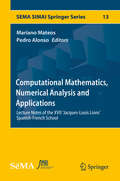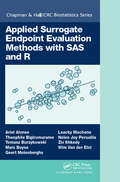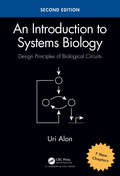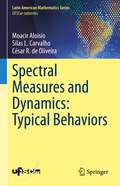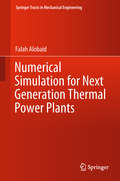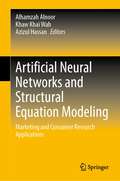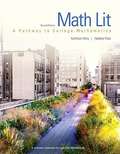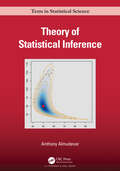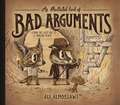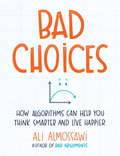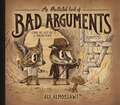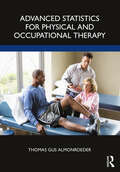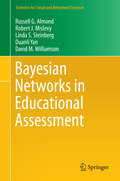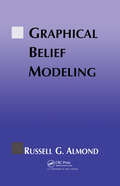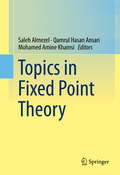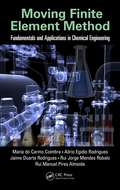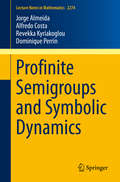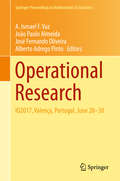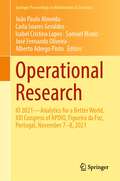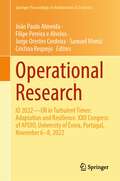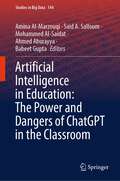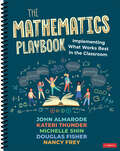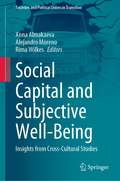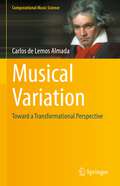- Table View
- List View
Computational Mathematics, Numerical Analysis and Applications: Lecture Notes of the XVII 'Jacques-Louis Lions' Spanish-French School (SEMA SIMAI Springer Series #13)
by Pedro Alonso Mariano MateosThe first part of this volume gathers the lecture notes of the courses of the "XVII Escuela Hispano-Francesa", held in Gij#65533;n, Spain, in June 2016. Each chapter is devoted to an advanced topic and presents state-of-the-art research in a didactic and self-contained way. Young researchers will find a complete guide to beginning advanced work in fields such as High Performance Computing, Numerical Linear Algebra, Optimal Control of Partial Differential Equations and Quantum Mechanics Simulation, while experts in these areas will find a comprehensive reference guide, including some previously unpublished results, and teachers may find these chapters useful as textbooks in graduate courses. The second part features the extended abstracts of selected research work presented by the students during the School. It highlights new results and applications in Computational Algebra, Fluid Mechanics, Chemical Kinetics and Biomedicine, among others, offering interested researchers a convenient reference guide to these latest advances.
Applied Surrogate Endpoint Evaluation Methods with SAS and R (Chapman & Hall/CRC Biostatistics Series)
by Ariel Alonso Theophile Bigirumurame Tomasz Burzykowski Marc Buyse Geert Molenberghs Leacky Muchene Nolen Joy Perualila Ziv Shkedy Wim Van der ElstAn important factor that affects the duration, complexity and cost of a clinical trial is the endpoint used to study the treatment’s efficacy. When a true endpoint is difficult to use because of such factors as long follow-up times or prohibitive cost, it is sometimes possible to use a surrogate endpoint that can be measured in a more convenient or cost-effective way. This book focuses on the use of surrogate endpoint evaluation methods in practice, using SAS and R.
An Introduction to Systems Biology: Design Principles of Biological Circuits, Second Edition (Chapman & Hall/CRC Mathematical and Computational Biology)
by Uri AlonPraise for the first edition: … superb, beautifully written and organized work that takes an engineering approach to systems biology. Alon provides nicely written appendices to explain the basic mathematical and biological concepts clearly and succinctly without interfering with the main text. He starts with a mathematical description of transcriptional activation and then describes some basic transcription-network motifs (patterns) that can be combined to form larger networks. – Nature [This text deserves] serious attention from any quantitative scientist who hopes to learn about modern biology … It assumes no prior knowledge of or even interest in biology … One final aspect that must be mentioned is the wonderful set of exercises that accompany each chapter. … Alon’s book should become a standard part of the training of graduate students. – Physics Today Written for students and researchers, the second edition of this best-selling textbook continues to offer a clear presentation of design principles that govern the structure and behavior of biological systems. It highlights simple, recurring circuit elements that make up the regulation of cells and tissues. Rigorously classroom-tested, this edition includes new chapters on exciting advances made in the last decade. Features: Includes seven new chapters The new edition has 189 exercises, the previous edition had 66 Offers new examples relevant to human physiology and disease
Spectral Measures and Dynamics: Typical Behaviors (Latin American Mathematics Series)
by Moacir Aloisio Silas L. Carvalho César R. de OliveiraThis book convenes and deepens generic results about spectral measures, many of them available so far in scattered literature. It starts with classic topics such as Wiener lemma, Strichartz inequality, and the basics of fractal dimensions of measures, progressing to more advanced material, some of them developed by the own authors.A fundamental concept to the mathematical theory of quantum mechanics, the spectral measure relates to the components of the quantum state concerning the energy levels of the Hamiltonian operator and, on the other hand, to the dynamics of such state. However, these correspondences are not immediate, with many nuances and subtleties discovered in recent years.A valuable example of such subtleties is found in the so-called “Wonderland theorem” first published by B. Simon in 1995. It shows that, for some metric space of self-adjoint operators, the set of operators whose spectral measures are singular continuous is a generic set (which, for some, is exotic). Recent works have revealed that, on top of singular continuity, there are other generic properties of spectral measures. These properties are usually associated with a number of different notions of generalized dimensions, upper and lower dimensions, with dynamical implications in quantum mechanics, ergodicity of dynamical systems, and evolution semigroups. All this opens ways to new and instigating avenues of research.Graduate students with a specific interest in the spectral properties of spectral measure are the primary target audience for this work, while researchers benefit from a selection of important results, many of them presented in the book format for the first time.
Numerical Simulation for Next Generation Thermal Power Plants (Springer Tracts in Mechanical Engineering)
by Falah AlobaidThe book provides highly specialized researchers and practitioners with a major contribution to mathematical models’ developments for energy systems. First, dynamic process simulation models based on mixture flow and two-fluid models are developed for combined-cycle power plants, pulverised coal-fired power plants, concentrated solar power plant and municipal waste incineration. Operation data, obtained from different power stations, are used to investigate the capability of dynamic models to predict the behaviour of real processes and to analyse the influence of modeling assumptions on simulation results. Then, a computational fluid dynamics (CFD) simulation programme, so-called DEMEST, is developed. Here, the fluid-solid, particle-particle and particle-wall interactions are modeled by tracking all individual particles. To this purpose, the deterministic Euler-Lagrange/Discrete Element Method (DEM) is applied and further improved. An emphasis is given to the determination of inter-phase values, such as volumetric void fraction, momentum and heat transfers, using a new procedure known as the offset-method and to the particle-grid method allowing the refinement of the grid resolution independently from particle size. Model validation is described in detail. Moreover, thermochemical reaction models for solid fuel combustion are developed based on quasi-single-phase, two-fluid and Euler-Lagrange/MP-PIC models. Measurements obtained from actual power plants are used for validation and comparison of the developed numerical models.
Artificial Neural Networks and Structural Equation Modeling: Marketing and Consumer Research Applications
by Alhamzah Alnoor Khaw Khai Wah Azizul HassanThis book goes into a detailed investigation of adapting artificial neural network (ANN) and structural equation modeling (SEM) techniques in marketing and consumer research. The aim of using a dual-stage SEM and ANN approach is to obtain linear and non-compensated relationships because the ANN method captures non-compensated relationships based on the black box technology of artificial intelligence. Hence, the ANN approach validates the results of the SEM method. In addition, such the novel emerging approach increases the validity of the prediction by determining the importance of the variables. Consequently, the number of studies using SEM-ANN has increased, but the different types of study cases that show customization of different processes in ANNs method combination with SEM are still unknown, and this aspect will be affecting to the generation results. Thus, there is a need for further investigation in marketing and consumer research. This book bridges the significant gap in this research area. The adoption of SEM and ANN techniques in social commerce and consumer research is massive all over the world. Such an expansion has generated more need to learn how to capture linear and non-compensatory relationships in such area. This book would be a valuable reading companion mainly for business and management students in higher academic organizations, professionals, policy-makers, and planners in the field of marketing. This book would also be appreciated by researchers who are keenly interested in social commerce and consumer research.
Math Lit: Pathway To College Mathematics
by Kathleen Almy Heather FoesThis text provides a one-semester alternative to the traditional two-semester developmental algebra sequence for non-STEM (Science, Technology, Engineering, and Math) students. This new approach offers an accelerated pathway to college readiness through developmental math, preparing non-STEM students to move directly into liberal arts math or introductory statistics, while also preparing STEM students for intermediate algebra.
Theory of Statistical Inference (Chapman & Hall/CRC Texts in Statistical Science)
by Anthony AlmudevarTheory of Statistical Inference is designed as a reference on statistical inference for researchers and students at the graduate or advanced undergraduate level. It presents a unified treatment of the foundational ideas of modern statistical inference, and would be suitable for a core course in a graduate program in statistics or biostatistics. The emphasis is on the application of mathematical theory to the problem of inference, leading to an optimization theory allowing the choice of those statistical methods yielding the most efficient use of data. The book shows how a small number of key concepts, such as sufficiency, invariance, stochastic ordering, decision theory and vector space algebra play a recurring and unifying role. The volume can be divided into four sections. Part I provides a review of the required distribution theory. Part II introduces the problem of statistical inference. This includes the definitions of the exponential family, invariant and Bayesian models. Basic concepts of estimation, confidence intervals and hypothesis testing are introduced here. Part III constitutes the core of the volume, presenting a formal theory of statistical inference. Beginning with decision theory, this section then covers uniformly minimum variance unbiased (UMVU) estimation, minimum risk equivariant (MRE) estimation and the Neyman-Pearson test. Finally, Part IV introduces large sample theory. This section begins with stochastic limit theorems, the δ-method, the Bahadur representation theorem for sample quantiles, large sample U-estimation, the Cramér-Rao lower bound and asymptotic efficiency. A separate chapter is then devoted to estimating equation methods. The volume ends with a detailed development of large sample hypothesis testing, based on the likelihood ratio test (LRT), Rao score test and the Wald test. Features This volume includes treatment of linear and nonlinear regression models, ANOVA models, generalized linear models (GLM) and generalized estimating equations (GEE). An introduction to decision theory (including risk, admissibility, classification, Bayes and minimax decision rules) is presented. The importance of this sometimes overlooked topic to statistical methodology is emphasized. The volume emphasizes throughout the important role that can be played by group theory and invariance in statistical inference. Nonparametric (rank-based) methods are derived by the same principles used for parametric models and are therefore presented as solutions to well-defined mathematical problems, rather than as robust heuristic alternatives to parametric methods. Each chapter ends with a set of theoretical and applied exercises integrated with the main text. Problems involving R programming are included. Appendices summarize the necessary background in analysis, matrix algebra and group theory.
An Illustrated Book of Bad Arguments
by Ali Almossawi Alejandro GiraldoThe antidote to fuzzy thinking, with furry animals! <P><P>Have you read (or stumbled into) one too many irrational online debates? Ali Almossawi certainly had, so he wrote An Illustrated Book of Bad Arguments! This handy guide is here to bring the internet age a much-needed dose of old-school logic (really old-school, a la Aristotle). <P><P>Here are cogent explanations of the straw man fallacy, the slippery slope argument, the ad hominem attack, and other common attempts at reasoning that actually fall short—plus a beautifully drawn menagerie of animals who (adorably) commit every logical faux pas. Rabbit thinks a strange light in the sky must be a UFO because no one can prove otherwise (the appeal to ignorance). And Lion doesn’t believe that gas emissions harm the planet because, if that were true, he wouldn’t like the result (the argument from consequences). <P><P>Once you learn to recognize these abuses of reason, they start to crop up everywhere from congressional debate to YouTube comments—which makes this geek-chic book a must for anyone in the habit of holding opinions.
Bad Choices: How Algorithms Can Help You Think Smarter and Live Happier
by Ali AlmossawiThe wildly popular author of Bad Arguments returns with a funny, smart introduction to algorithms—those perennially misunderstood, increasingly important problem-solving rules that can save you time and lead to better choices, every day. Why is Facebook so good at predicting what you like? How do you discover new music? What's the best way to sort your laundry?Readers around the world have embraced Ali Almossawi's whimsical illustrations—drawn by his collaborator Alejandro Giraldo—and his funny, clarifying explanations of complex subjects. In fewer than 200 pages, Almossawi demystifies a new topic of increasing relevance to our lives: algorithms. Bad Choices is a book for anyone who's looked at a given task and wondered if there was a better, faster way to get the task done. What's the best way to organize a grocery list? What's the secret to being more productive at work? How can we better express ourselves in 140-characters? Presenting us with alternative methods for tackling twelve different scenarios, Almossawi guides us to better choices that borrow from same systems that underline a computer word processor, a Google search engine, or a Facebook ad. Once you recognize what makes a method faster and more efficient, you'll become a more nimble, creative problem-solver, ready to face new challenges. Bad Choices will open the world of algorithms to all readers making this a perennial go-to for fans of quirky, accessible science books.From the Hardcover edition.
An Illustrated Book of Bad Arguments: Learn The Lost Art Of Making Sense (Bad Arguments #0)
by Ali Almossawi“This short book makes you smarter than 99% of the population. . . . The concepts within it will increase your company’s ‘organizational intelligence.’. . . It’s more than just a must-read, it’s a ‘have-to-read-or-you’re-fired’ book.”—Geoffrey James, INC.com From the author of An Illustrated Book of Loaded Language, here’s the antidote to fuzzy thinking, with furry animals! Have you read (or stumbled into) one too many irrational online debates? Ali Almossawi certainly had, so he wrote An Illustrated Book of Bad Arguments! This handy guide is here to bring the internet age a much-needed dose of old-school logic (really old-school, a la Aristotle). Here are cogent explanations of the straw man fallacy, the slippery slope argument, the ad hominem attack, and other common attempts at reasoning that actually fall short—plus a beautifully drawn menagerie of animals who (adorably) commit every logical faux pas. Rabbit thinks a strange light in the sky must be a UFO because no one can prove otherwise (the appeal to ignorance). And Lion doesn’t believe that gas emissions harm the planet because, if that were true, he wouldn’t like the result (the argument from consequences). Once you learn to recognize these abuses of reason, they start to crop up everywhere from congressional debate to YouTube comments—which makes this geek-chic book a must for anyone in the habit of holding opinions.
Advanced Statistics for Physical and Occupational Therapy
by Thomas Gus AlmonroederAdvanced Statistics for Physical and Occupational Therapy explains the basis for statistical analyses that are commonly used to answer clinical research questions related to physical and occupational therapy. This textbook provides a resource to help students and faculty in physical and occupational therapy graduate programs understand the basis for common statistical analyses and be able to apply these techniques in their own research. This textbook provides readers with the basis for common statistical analyses, including t-tests, analysis of variance, regression, and nonparametric tests. Each chapter includes step-by-step tutorials with corresponding example data sets explaining how to conduct these statistical analyses using Statistical Package for the Social Sciences (SPSS) software and the Excel Analysis ToolPak, as well as how to identify and interpret relevant output and report results. Advanced Statistics for Physical and Occupational Therapy is key reading for students in physical therapy, occupational therapy, sport performance, and sport rehabilitation graduate programs as well as students in athletic training courses, applied statistics in sport, and research methods in sport modules. This new text will also be of interest to practicing clinicians who hope to better understand the research they are reading and/or are interested in starting to conduct their own clinical research.
Bayesian Networks in Educational Assessment (Statistics for Social and Behavioral Sciences)
by Russell G. Almond Robert J. Mislevy Linda S. Steinberg Duanli Yan David M. WilliamsonBayesian inference networks, a synthesis of statistics and expert systems, have advanced reasoning under uncertainty in medicine, business, and social sciences. This innovative volume is the first comprehensive treatment exploring how they can be applied to design and analyze innovative educational assessments. Part I develops Bayes nets' foundations in assessment, statistics, and graph theory, and works through the real-time updating algorithm. Part II addresses parametric forms for use with assessment, model-checking techniques, and estimation with the EM algorithm and Markov chain Monte Carlo (MCMC). A unique feature is the volume's grounding in Evidence-Centered Design (ECD) framework for assessment design. This "design forward" approach enables designers to take full advantage of Bayes nets' modularity and ability to model complex evidentiary relationships that arise from performance in interactive, technology-rich assessments such as simulations. Part III describes ECD, situates Bayes nets as an integral component of a principled design process, and illustrates the ideas with an in-depth look at the BioMass project: An interactive, standards-based, web-delivered demonstration assessment of science inquiry in genetics. This book is both a resource for professionals interested in assessment and advanced students. Its clear exposition, worked-through numerical examples, and demonstrations from real and didactic applications provide invaluable illustrations of how to use Bayes nets in educational assessment. Exercises follow each chapter, and the online companion site provides a glossary, data sets and problem setups, and links to computational resources.
Graphical Belief Modeling
by Russel .G AlmondThis innovative volume explores graphical models using belief functions as a representation of uncertainty, offering an alternative approach to problems where probability proves inadequate. Graphical Belief Modeling makes it easy to compare the two approaches while evaluating their relative strengths and limitations. The author examines both theory and computation, incorporating practical notes from the author's own experience with the BELIEF software package. As one of the first volumes to apply the Dempster-Shafer belief functions to a practical model, a substantial portion of the book is devoted to a single example--calculating the reliability of a complex system. This special feature enables readers to gain a thorough understanding of the application of this methodology.The first section provides a description of graphical belief models and probablistic graphical models that form an important subset: the second section discusses the algorithm used in the manipulation of graphical models: the final segment of the book offers a complete description of the risk assessment example, as well as the methodology used to describe it. Graphical Belief Modeling offers researchers and graduate students in artificial intelligence and statistics more than just a new approach to an old reliability task: it provides them with an invaluable illustration of the process of graphical belief modeling.
Topics in Fixed Point Theory
by Saleh Almezel Qamrul Hasan Ansari Mohamed Amine KhamsiThe purpose of this contributed volume is to provide a primary resource for anyone interested in fixed point theory with a metric flavor. The book presents information for those wishing to find results that might apply to their own work and for those wishing to obtain a deeper understanding of the theory. The book should be of interest to a wide range of researchers in mathematical analysis as well as to those whose primary interest is the study of fixed point theory and the underlying spaces. The level of exposition is directed to a wide audience, including students and established researchers. Key topics covered include Banach contraction theorem, hyperconvex metric spaces, modular function spaces, fixed point theory in ordered sets, topological fixed point theory for set-valued maps, coincidence theorems, Lefschetz and Nielsen theories, systems of nonlinear inequalities, iterative methods for fixed point problems, and the Ekeland's variational principle.
Moving Finite Element Method: Fundamentals and Applications in Chemical Engineering
by Rui Manuel Almeida Maria do Coimbra Alirio Egidio Rodrigues Jaime Duarte Rodrigues Rui Jorge RobaloThis book focuses on process simulation in chemical engineering with a numerical algorithm based on the moving finite element method (MFEM). It offers new tools and approaches for modeling and simulating time-dependent problems with moving fronts and with moving boundaries described by time-dependent convection-reaction-diffusion partial differential equations in one or two-dimensional space domains. It provides a comprehensive account of the development of the moving finite element method, describing and analyzing the theoretical and practical aspects of the MFEM for models in 1D, 1D+1d, and 2D space domains. Mathematical models are universal, and the book reviews successful applications of MFEM to solve engineering problems. It covers a broad range of application algorithm to engineering problems, namely on separation and reaction processes presenting and discussing relevant numerical applications of the moving finite element method derived from real-world process simulations.
Profinite Semigroups and Symbolic Dynamics (Lecture Notes in Mathematics #2274)
by Jorge Almeida Alfredo Costa Revekka Kyriakoglou Dominique PerrinThis book describes the relation between profinite semigroups and symbolic dynamics. Profinite semigroups are topological semigroups which are compact and residually finite. In particular, free profinite semigroups can be seen as the completion of free semigroups with respect to the profinite metric. In this metric, two words are close if one needs a morphism on a large finite monoid to distinguish them. The main focus is on a natural correspondence between minimal shift spaces (closed shift-invariant sets of two-sided infinite words) and maximal J-classes (certain subsets of free profinite semigroups). This correspondence sheds light on many aspects of both profinite semigroups and symbolic dynamics. For example, the return words to a given word in a shift space can be related to the generators of the group of the corresponding J-class. The book is aimed at researchers and graduate students in mathematics or theoretical computer science.
Operational Research
by João Paulo Almeida José Fernando Oliveira Alberto Adrego Pinto A. Ismael VazThis proceedings book presents selected contributions from the XVIII Congress of APDIO (the Portuguese Association of Operational Research) held in Valença on June 28–30, 2017. Prepared by leading Portuguese and international researchers in the field of operations research, it covers a wide range of complex real-world applications of operations research methods using recent theoretical techniques, in order to narrow the gap between academic research and practical applications. Of particular interest are the applications of, nonlinear and mixed-integer programming, data envelopment analysis, clustering techniques, hybrid heuristics, supply chain management, and lot sizing and job scheduling problems. In most chapters, the problems, methods and methodologies described are complemented by supporting figures, tables and algorithms.The XVIII Congress of APDIO marked the 18th installment of the regular biannual meetings of APDIO – the Portuguese Association of Operational Research. The meetings bring together researchers, scholars and practitioners, as well as MSc and PhD students, working in the field of operations research to present and discuss their latest works. The main theme of the latest meeting was Operational Research Pro Bono. Given the breadth of topics covered, the book offers a valuable resource for all researchers, students and practitioners interested in the latest trends in this field.
Operational Research: IO 2021—Analytics for a Better World. XXI Congress of APDIO, Figueira da Foz, Portugal, November 7–8, 2021 (Springer Proceedings in Mathematics & Statistics #411)
by João Paulo Almeida Carla Soares Geraldes Isabel Cristina Lopes Samuel Moniz José Fernando Oliveira Alberto Adrego PintoThis book provides the current status of research on the application of OR methods to solve emerging and relevant operations management problems. Each chapter is a selected contribution of the IO2021 - XXI Congress of APDIO, the Portuguese Association of Operational Research, held in Figueira da Foz from 7 to 8 November 2021. Under the theme of analytics for a better world, the book presents interesting results and applications of OR cutting-edge methods and techniques to various real-world problems. Of particular importance are works applying nonlinear, multi-objective optimization, hybrid heuristics, multicriteria decision analysis, data envelopment analysis, simulation, clustering techniques and decision support systems, in different areas such as supply chain management, production planning and scheduling, logistics, energy, telecommunications, finance and health. All chapters were carefully reviewed by the members of the scientific program committee.
Operational Research: IO 2022—OR in Turbulent Times: Adaptation and Resilience. XXII Congress of APDIO, University of Évora, Portugal, November 6–8, 2022 (Springer Proceedings in Mathematics & Statistics #437)
by João Paulo Almeida Filipe Pereira e Alvelos Jorge Orestes Cerdeira Samuel Moniz Cristina RequejoThis book presents the XXII Congress of APDIO – IO 2022 which is the 22nd edition of the regular meeting of the Portuguese Association of Operational Research (APDIO). The APDIO regular meetings aim to gather Portuguese and international researchers, scholars and practitioners, as well as M.Sc. and Ph.D. students, working in the field of Operations Research to present and discuss their latest research works. The main theme of the XXII Congress of APDIO is OR in Turbulent Times: Adaptation and Resilience.Readers find interesting results and applications of Operational Research cutting-edge methods and techniques in the wide variety of the addressed problems. Of particular interest are the applications of, among others, linear, nonlinear and mixed-integer programing, multiobjective optimization, metaheuristics and hybrid heuristics, multicriteria decision analysis, data envelopment analysis, simulation, clustering techniques and decision support systems, in different areas such as, supply chain management, scheduling problems, production management, logistics, energy, telecommunications, finance and health.
Artificial Intelligence in Education: The Power and Dangers of ChatGPT in the Classroom (Studies in Big Data #144)
by Amina Al-Marzouqi Said A. Salloum Mohammed Al-Saidat Ahmed Aburayya Babeet GuptaThis book aims to bring together a collection of innovative and cutting-edge research that addresses the various challenges in the application and theoretical aspects of ChatGPT in education. ChatGPT is a large language model developed by OpenAI that has the ability to generate human-like text based on a prompt. This has significant potential for use in the field of education, as it allows for the creation of personalized, interactive learning experiences, automating assessment and grading, and more. In e-learning, ChatGPT is used to provide instant feedback and support to students, as well as generate interactive conversations in the target language for language learning. It is also integrated with existing learning management systems and educational technology platforms to enhance their capabilities. In research, ChatGPT is used for natural language processing and sentiment analysis to gather insights on student learning experiences and educational outcomes. However, it is important to note that there are also ethical and privacy concerns that come with using language models like ChatGPT in education, such as data protection and the potential for bias. Overall, the use of ChatGPT in education has the potential to revolutionize the way we learn, teach, and access information. The book seeks to publish original manuscripts that cover a broad range of topics, from the development of new chatbot technologies and their integration into the classroom, to the examination of the ethical and pedagogical implications of these systems. By compiling the latest developments in the field and highlighting new areas for exploration, this book provides valuable insights and perspectives for researchers, educators, and practitioners working in the field of ChatGPT and education. The ultimate goal is to advance the understanding of ChatGPT and its role in education and to promote its effective and responsible use in the classroom and beyond.
The Mathematics Playbook: Implementing What Works Best in the Classroom
by John T. Almarode Kateri Thunder Michelle Shin Douglas Fisher Nancy FreyYour Guide to Engaging and Effective Math Instruction With the latest research on what works best in teaching and learning, The Mathematics Playbook is your comprehensive guide to enhancing mathematics teaching and learning. With a focus on fostering equity and maximizing student learning, the authors provide practical modules that integrate the latest research on effective teaching practices, and answer four critical questions: How do we foster, nurture, and sustain mathematics learning? How do we ensure all learners have equity of access and opportunity? What are the non-negotiables in a high-quality mathematics task? How do we know if learners really "get it"? Through real-life examples and an emphasis on self-assessment and reflection, this playbook empowers you to create engaging and impactful learning experiences in mathematics.
The Mathematics Playbook: Implementing What Works Best in the Classroom
by John T. Almarode Kateri Thunder Michelle Shin Douglas Fisher Nancy FreyYour Guide to Engaging and Effective Math Instruction With the latest research on what works best in teaching and learning, The Mathematics Playbook is your comprehensive guide to enhancing mathematics teaching and learning. With a focus on fostering equity and maximizing student learning, the authors provide practical modules that integrate the latest research on effective teaching practices, and answer four critical questions: How do we foster, nurture, and sustain mathematics learning? How do we ensure all learners have equity of access and opportunity? What are the non-negotiables in a high-quality mathematics task? How do we know if learners really "get it"? Through real-life examples and an emphasis on self-assessment and reflection, this playbook empowers you to create engaging and impactful learning experiences in mathematics.
Social Capital and Subjective Well-Being: Insights from Cross-Cultural Studies (Societies and Political Orders in Transition)
by Anna Almakaeva Alejandro Moreno Rima WilkesThis book presents a cross-cultural investigation into the interplay between social capital and subjective well-being. Based on a quantitative analysis of the latest large-N cross-cultural data sets, including the World Value Survey and the European Social Survey, and covering various countries, it offers a comparative perspective on and new insights into the determinants of social capital and well-being. By identifying both universal and culture-specific patterns, the authors shed new light on the spatial and temporal differentiation of social capital and subjective well-being. The book is divided into two main parts: The first discusses mutual trust, religious and cultural tolerance, and pro-social and human values as essential dimensions of social capital. In turn, the second part studies social capital as a source of subjective well-being and life satisfaction. Given its scope, the book will appeal to scholars of sociology, social psychology, political science and economics seeking a deeper understanding of the multi-faceted nature of social capital and well-being.
Musical Variation: Toward a Transformational Perspective (Computational Music Science)
by Carlos de AlmadaThis book offers an in-depth analysis of musical variation through a systematic approach, heavily influenced by the principles of Grundgestalt and developed variations, both created by the Austrian composer Arnold Schoenberg (1874-1951). The author introduces a new transformational-derivative model and the theory that supports it, specifically crafted for the examination of tonal music.The idea for this book emerged during a sabbatical at Columbia University, while the content is the product of extensive research conducted at the Federal University of Rio de Janeiro, resulting in the development of the Model of Derivative Analysis. This model places emphasis on the connections between musical entities rather than viewing them as separate entities. As a case study, the Intermezzo in A Major Op.118/2 by Brahms is selected for analysis.The author's goal is to provide a formal and structured approach while maintaining the text's readability and appeal for both musicians and mathematicians in the field of music theory. The book concludes with the author's recommendations for further research.
